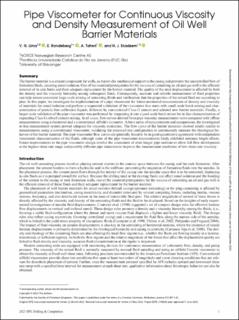| dc.contributor.author | Nogueira Lima, Victor | |
| dc.contributor.author | Randeberg, Erlend | |
| dc.contributor.author | Taheri, Amir | |
| dc.contributor.author | Skadsem, Hans Joakim | |
| dc.date.accessioned | 2023-09-15T08:05:19Z | |
| dc.date.available | 2023-09-15T08:05:19Z | |
| dc.date.created | 2023-06-21T19:49:23Z | |
| dc.date.issued | 2023 | |
| dc.identifier.citation | SPE Drilling & Completion. 2023, 1-14. | en_US |
| dc.identifier.issn | 1064-6671 | |
| dc.identifier.uri | https://hdl.handle.net/11250/3089645 | |
| dc.description.abstract | The barrier material is a crucial component for wells, as it provides mechanical support to the casing and prevents the uncontrolled flow of formation fluids, ensuring zonal isolation. One of the essential prerequisites for the success of cementing an oil and gas well is the efficient removal of in-situ fluids and their adequate replacement by the barrier material. The quality of the mud displacement is affected by both the density and the viscosity hierarchy among subsequent fluids. Consequently, accurate and reliable measurement of fluid properties can help ensure consistent large-scale mixing of cementing fluids and verification that the properties of the mixed fluid are according to plan. In this paper, we investigate the implementation of a pipe viscometer for future automated measurements of density and viscosity of materials for zonal isolation and perform a sequential validation of the viscometer that starts with small-scale batch mixing and characterization of particle-free calibration liquids, followed by conventional Class G cement and selected new barrier materials. Finally, a larger-scale validation of the pipe viscometer was performed by integrating it into a yard-scale batch mixer for in-line characterization of expanding Class G oilwell cement mixing. In all cases, flow curves derived from pipe viscosity measurements were compared with offline measurements using a rheometer and a conventional oilfield viscometer. After a series of measurements and comparisons, the investigated in-line measurement system proved adequate for viscosity estimation. The flow curve of the barrier materials showed results similar to measurements using a conventional viscometer, validating the proposed test configuration to continuously measure the rheological behavior of the barrier material. The pipe viscometer flow curves are generally found to be in good quantitative agreement with independent viscometer characterization of the fluids, although some of the pipe viscometer measurements likely exhibited entrance length effects. Future improvements to the pipe viscometer design involve the assessment of even longer pipe sections to allow full flow development at the highest shear rate range and possibly different pipe diameters to improve the measurement resolution of low-shear rate viscosity. | en_US |
| dc.description.abstract | Pipe Viscometer for Continuous Viscosity and Density Measurement of Oil Well Barrier Materials | en_US |
| dc.language.iso | eng | en_US |
| dc.rights | Navngivelse 4.0 Internasjonal | * |
| dc.rights.uri | http://creativecommons.org/licenses/by/4.0/deed.no | * |
| dc.title | Pipe Viscometer for Continuous Viscosity and Density Measurement of Oil Well Barrier Materials | en_US |
| dc.title.alternative | Pipe Viscometer for Continuous Viscosity and Density Measurement of Oil Well Barrier Materials | en_US |
| dc.type | Peer reviewed | en_US |
| dc.type | Journal article | en_US |
| dc.rights.holder | © 2023 The Authors | en_US |
| dc.description.version | publishedVersion | en_US |
| cristin.ispublished | true | |
| cristin.fulltext | original | |
| cristin.qualitycode | 1 | |
| dc.identifier.doi | 10.2118/215833-PA | |
| dc.identifier.cristin | 2156783 | |
| dc.source.journal | SPE Drilling & Completion | en_US |
| dc.source.pagenumber | 1-14 | en_US |
| dc.relation.project | Norges forskningsråd: 309646 | en_US |
| dc.relation.project | Norges forskningsråd: 296009 | en_US |

